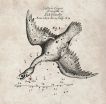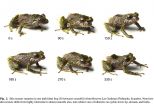Some of seventeenth century's greatest astronomers, including Hevelius -- the father of lunar cartography -- and Cassini, carefully documented the appearance of a new star in the skies in 1670. Hevelius described it as nova sub capite Cygni -- a new star below the head of the Swan -- but astronomers now know it by the name Nova Vulpeculae 1670 [1]. Historical accounts of novae are rare and of great interest to modern astronomers. Nova Vul 1670 is claimed to be both the oldest recorded nova and the faintest nova when later recovered.
The lead author of the new study, Tomasz Kami?ski (ESO and the Max Planck Institute for Radio Astronomy, Bonn, Germany) explains: "For many years this object was thought to be a nova, but the more it was studied the less it looked like an ordinary nova -- or indeed any other kind of exploding star."
When it first appeared, Nova Vul 1670 was easily visible with the naked eye and varied in brightness over the course of two years. It then disappeared and reappeared twice before vanishing for good. Although well documented for its time, the intrepid astronomers of the day lacked the equipment needed to solve the riddle of the apparent nova's peculiar performance.
During the twentieth century, astronomers came to understand that most novae could be explained by the runaway explosive behaviour of close binary stars. But Nova Vul 1670 did not fit this model well at all and remained a mystery.
Even with ever-increasing telescopic power, the event was believed for a long time to have left no trace, and it was not until the 1980s that a team of astronomers detected a faint nebula surrounding the suspected location of what was left of the star. While these observations offered a tantalising link to the sighting of 1670, they failed to shed any new light on the true nature of the event witnessed over the skies of Europe over three hundred years ago.
Tomasz Kami?ski continues the story: "We have now probed the area with submillimetre and radio wavelengths. We have found that the surroundings of the remnant are bathed in a cool gas rich in molecules, with a very unusual chemical composition."
As well as APEX, the team also used the Submillimeter Array (SMA) and the Effelsberg radio telescope to discover the chemical composition and measure the ratios of different isotopes in the gas. Together, this created an extremely detailed account of the makeup of the area, which allowed an evaluation of where this material might have come from.
What the team discovered was that the mass of the cool material was too great to be the product of a nova explosion, and in addition the isotope ratios the team measured around Nova Vul 1670 were different to those expected from a nova. But if it wasn't a nova, then what was it?
The answer is a spectacular collision between two stars, more brilliant than a nova, but less so than a supernova, which produces something called a red transient. These are a very rare events in which stars explode due to a merger with another star, spewing material from the stellar interiors into space, eventually leaving behind only a faint remnant embedded in a cool environment, rich in molecules and dust. This newly recognised class of eruptive stars fits the profile of Nova Vul 1670 almost exactly.
Co-author Karl Menten (Max Planck Institute for Radio Astronomy, Bonn, Germany) concludes: "This kind of discovery is the most fun: something that is completely unexpected!"
INFORMATION:
Notes
[1] This object lies within the boundaries of the modern constellation of Vulpecula (The Fox), just across the border from Cygnus (constellation) (The Swan). It is also often referred to as Nova Vul 1670 and CK Vulpeculae, its designation as a variable star.
More information
This research was presented in a paper entitled "Nuclear ashes and outflow in the oldest known eruptive star Nova Vul 1670" by T. Kami?ski et al., to appear online in the journal Nature on 23 March 2015.
The team is composed of Tomasz Kami?ski (ESO, Santiago, Chile; Max Planck Institute for Radio Astronomy, Bonn, Germany [MPIfR]), Karl M. Menten (MPIfR), Romuald Tylenda (N. Copernicus Astronomical Center, Toru?, Poland), Marcin Hajduk (N. Copernicus Astronomical Center), Nimesh A. Patel (Harvard-Smithsonian Center for Astrophysics, Cambridge, Massachusetts, USA) and Alexander Kraus (MPIfR).
APEX is a collaboration between the Max Planck Institute for Radio Astronomy (MPIfR), the Onsala Space Observatory (OSO) and ESO. Operation of APEX at Chajnantor is entrusted to ESO.
ESO is the foremost intergovernmental astronomy organisation in Europe and the world's most productive ground-based astronomical observatory by far. It is supported by 16 countries: Austria, Belgium, Brazil, the Czech Republic, Denmark, France, Finland, Germany, Italy, the Netherlands, Poland, Portugal, Spain, Sweden, Switzerland and the United Kingdom, along with the host state of Chile. ESO carries out an ambitious programme focused on the design, construction and operation of powerful ground-based observing facilities enabling astronomers to make important scientific discoveries. ESO also plays a leading role in promoting and organising cooperation in astronomical research. ESO operates three unique world-class observing sites in Chile: La Silla, Paranal and Chajnantor. At Paranal, ESO operates the Very Large Telescope, the world's most advanced visible-light astronomical observatory and two survey telescopes. VISTA works in the infrared and is the world's largest survey telescope and the VLT Survey Telescope is the largest telescope designed to exclusively survey the skies in visible light. ESO is a major partner in ALMA, the largest astronomical project in existence. And on Cerro Armazones, close to Paranal, ESO is building the 39-metre European Extremely Large Telescope, the E-ELT, which will become "the world's biggest eye on the sky".
Links
Research paper in Nature - http://www.eso.org/public/archives/releases/sciencepapers/eso1511/eso1511a.pdf
Photos of APEX - http://www.eso.org/public/images/archive/search/?adv=&subject_name=Atacama%20Pathfinder%20Experiment
Contacts
Tomasz Kami?ski
ESO / Max-Planck-Institut für Radioastronomie
Santiago / Bonn, Chile / Germany
Tel: +56 02 2463 3277
Email: tkaminsk@eso.org
Karl Menten
Max-Planck-Institut für Radioastronomie
Bonn, Germany
Tel: +49 228 525 297
Email: kmenten@mpifr-bonn.mpg.de
Romuald Tylenda
Nicolaus Copernicus Astronomical Centre
Toru?, Poland
Tel: +48 56 6219319 ext. 11
Cell: +48 600 286 131
Email: tylenda@ncac.torun.pl
Richard Hook
ESO, Public Information Officer
Garching bei München, Germany
Tel: +49 89 3200 6655
Cell: +49 151 1537 3591
Email: rhook@eso.org



